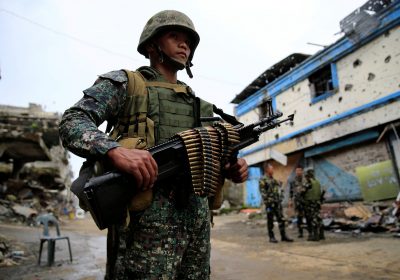The battle of Marawi formally ended in October 2017. The leaders of the violent extremist takeover are confirmed dead, half of the city’s residents have returned and Mindanao State University re-opened its Marawi campus in August. After taking five months to quell the uprising, the Armed Forces of the Philippines have admitted that they lack skills in urban combat and are already receiving training assistance provided by Australia and Singapore. There are reasons to be gravely concerned about the battle’s aftermath.

Urban rehabilitation is going to be long and contentious. The main battleground was a crowded, built-up area filled with sturdy concrete structures. Formerly well-off residents have lost everything, since they evacuated under the assumption that they would be back in a few days instead of five months. The extremists used urban warfare tactics (such as tunnelling through walls between houses to avoid exposure) and the Philippine military responded by bombing and shelling as they fought house to house. As engineers render the area safe, they are recovering considerable amounts of unexploded ordnance and large numbers of improvised explosive devices.
Aside from the danger of explosion, other factors complicate residents’ returning to the city. Properties often did not have formal titles (a common occurrence in the Philippines), which makes reoccupation of residential lots uncertain. A former presidential decree proclaiming that much of Marawi is a military reservation further complicates land ownership: when the military says it won’t take more land than it needs, residents are hardly assured. The government has announced plans for a four-lane highway through the city, for promenades along Lake Lanao and the Agus River and for other modern urban infrastructure projects, all of which are likely to further displace residents. Residents have lost everything, are not able to return and have a very murky future — a situation that could easily lead to discontent.
Another source of concern is the ability of violent extremist recruiters to fish in these troubled waters. The Marawi incident clearly rose above the long-running threat levels posed by the Bangsamoro Islamic Freedom Fighters in central Mindanao and by the Abu Sayyaf in the Sulu archipelago. This was partly due to support from the core leadership of the so-called Islamic State (IS) both in terms of financing and in terms of convincing disparate groups to work together — in particular by getting Isnilon Hapilon, IS’s designated emir in the region, to move from his jungle lair to the Lanao area where the Maute brothers led another group. Even after these leaders’ demise in combat, recruitment continues. Any assessment of the threat of violent extremism in the Philippines needs to appreciate the local realities in which it might be rooted.
Progress on legislating peace agreements reached with the mainstream Moro Islamic Liberation Front and the Moro National Liberation Front has slowed. This has occurred in spite of the optimism and trust that greeted the election of Rodrigo Duterte as the first president from Mindanao. Throughout his first 18 months in office, Duterte has been systematically unclear about the relation between the Bangsamoro Basic Law — which was written to establish a more autonomous regional entity in Muslim-majority areas of Mindanao — and his proposed constitutional amendments that turn the entire country from a unitary into a federal state.
The Philippine Congress is treating the Bangsamoro Basic Law not as an implementation of agreements reached by the executive branch in negotiations but as a piece of legislation subject to the independent judgement of the Congress. While this may seem reasonable to an elected government official, in the eyes of the Moro Fronts the delays once more raise the possibility of the non-implementation of formally signed agreements — an event that has occurred repeatedly over the past 40 years.
At the rhetorical level, such a failure would play into the recruitment pitch of the violent extremists, who argue that non-Muslims will always deceive Muslims and that the peace process is a deception. The Moro Islamic Liberation Front and the Moro National Liberation Front would seem to be traitors who have turned their backs on true jihad.
At a practical level, cooperation by the Fronts with the Philippine military in action against militants is ongoing. The continuation of this arrangement depends on the Fronts’ ability to project their ‘Bangsamoro’ narrative against the claim by militants that a caliphate is the answer to the grievances of Muslims.
The Philippines must do more to inform and involve local communities in the rehabilitation of Marawi city in order to reduce uncertainty. The Congress needs to implement agreements already reached with the respective Fronts to demonstrate their ability to deliver results to the region. The government additionally must increase the resilience of affected local communities, their leaders and families to reduce the effects of recruitment by extremists. If they do not, the past year may well only be phase one in the Battle of Marawi.
[Steven Rood is Visiting Fellow at the Department of Political and Social Change at the Australian National University and a Fellow and Board Member of Social Weather Stations in the Philippines.]
http://www.eastasiaforum.org/2018/02/02/the-struggle-for-marawi-has-only-just-begun/

No comments:
Post a Comment
Note: Only a member of this blog may post a comment.